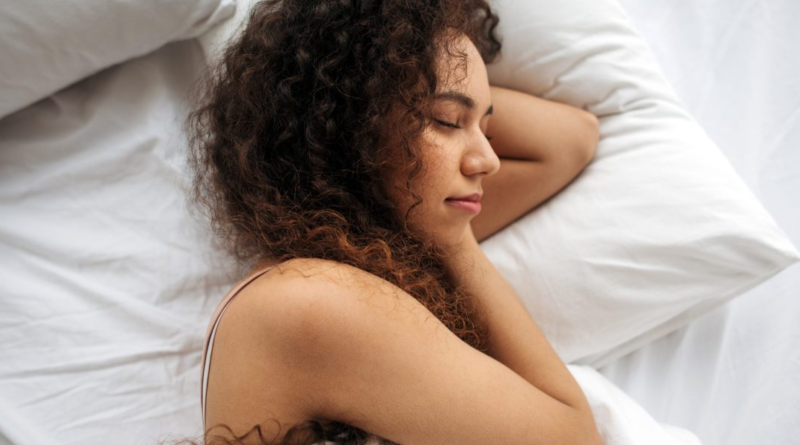I took Headspace’s guided sleep course and I’m finally getting a good night’s rest. Here are the 5 habits I learned
I still don’t know how the “Enchanted Moonlight Library” sleepcast episode ends. Which, I suppose, is the point. A sleepcast is exactly what it sounds like: a podcast intended to help you doze off. Or, perhaps I have heard “the end” and never knew it; Headspace, the mental health app housing the audio content, slightly remixes its bedtime stories nightly so anxious sleepers like me can’t track time by memorizing the narrative. (Sneaky, but effective, I can confirm.)
I began Headspace’s 18-session Finding Your Best Sleep course in April, seeking strategies to quiet my worry-prone mind and fall asleep more quickly. The lessons, which include brief videos and guided meditations, are spread across three modules: Understand your sleep; Try something new; and Practice, practice, practice.
For roughly 10 minutes a night for nearly three weeks, I embraced all the materials the program had to offer—even optional bonus videos that didn’t pertain to me, including ones on sleeping comfortably while pregnant and navigating shift work. This added perspective helped me triage my sleep habits and what I hoped to improve.
While not part of the course, the 45-minute-long sleepcasts are included with membership, along with other bedtime tools such as:
- Nighttime SOS: I utilized this feature a few times when I woke up in the middle of the night and couldn’t fall back asleep. The guided exercise track “Racing Mind SOS” came in handy.
- Sleep music and radio: The “Cave Winds” track and Rain Radio station are particularly relaxing.
- Soundscapes: “Indoor Fireplace” and “Cabin Downpour” are among my favorite cozy background noise tracks.
- White noise and sleep sounds: The delicate frequency of green noise works every time.
- Wind downs: “Deep Rest” is the track for me after a stressful day.
Headspace costs $12.99/month with a weeklong free trial, or $5.83/month billed as $69.99/year with a two-week free trial. Postsecondary students can join for 83 cents/month billed as $9.99/year.
By design, not every tool featured in Finding Your Best Sleep worked for me. Worry time, for instance, the practice of confining your worries to a dedicated chunk of time each day, only made me more restless. The goal of the course was to discover the best sleep hygiene for me, and that it did. Here are five of my favorite sleep strategies I learned from Headspace.
Safeguard your sleep
The program encouraged me to put into practice something I’ve long known to be true: When I sleep better, life is better.
Adults ages 18–60 need at least seven hours of sleep each night, according to the Centers for Disease Control and Prevention (CDC). If I get fewer than eight, getting through the next day is akin to wading through mud. With proper rest, I’m a better daughter, sister, friend, and employee. I’m not only more productive at home and work, but also kinder and happier.
Why, then, is achieving this crucial wellness component so difficult? The course urged me to not prioritize sleep but safeguard it—to respect it, protect it, and arrange the rest of my life to accommodate it instead of the other way around.
Sleep is a simple sacrifice when it seems there aren’t enough hours in the day to accomplish what needs to be done. Sometimes I still have to force myself to put aside whatever task feels like it can’t wait in order to put sleep first. And as if by magic, a solid night’s sleep gifts me time back the next day in the form of increased energy and efficiency.
Sleep space is sacred—including the bed
I knew that a calming bedroom environment is critical to restful sleep. Catching z’s in a cool, dark, quiet, and comfortable place is ideal, the CDC says. TVs in the bedroom are frowned upon, and screen time should be cut off at least 30 minutes before bedtime, especially when blue light is involved.
Headspace, however, stresses that the bed itself should be off-limits to just about anything other than sleeping. That means no eating, working, or doomscrolling in bed. That way, your brain associates the bed with sleep—not meals, emails, or social media.
We’ve all been there, but neither should your bed be a place you toss and turn in mental agony, mulling over yesterday’s mistakes and tomorrow’s to-do list. If trying to fall asleep makes your thoughts race and you’re still awake after 20 minutes or so, Finding Your Best Sleep recommends getting out of bed and doing a relaxing activity in another room until you’re sleepy.

Tetra Images/Getty Images
A good night’s sleep begins in the morning
Taking time each night to prepare for the next morning was already second nature to me; laying out my gym clothes and packing a lunch makes for a less hectic start to the day. But before Headspace, I hadn’t considered how I could prepare for a good night’s sleep throughout the day.
Because your wake-up time keeps your circadian rhythm, or body clock, in check, merely waking up at a consistent time every morning—yes, including weekends—primes you for falling asleep at your preferred bedtime. Sunlight exposure in the morning helps, too.
I’m not typically an afternoon coffee drinker, but intentionally limiting my lattes to before noon helps me wind down earlier in the evening. I also now eat dinner earlier to allow more time for digestion before bed. I’ve become more diligent about making my bed in the morning, which makes the evening turn-down a kind of ritual. I’ve even started laying out my pajamas in the morning and look forward to finding other ways to make my nights easier during the day.
Settle in with a story
Thanks, Mom, for always reading me to sleep; I’ve kept the security blanket of storytelling close. Yet when I read from my Kindle or iPad in bed, even on dark or warm-light mode, I’m still staring at a screen with distractions a tap away. Reading a physical book means my bedside lamp stays on, and when I listen to an audiobook in the dark, I find myself straining my ears to stay awake and listen.
This is where Headspace’s sleepcasts save the day. I still enjoy reading in the evening, but once I’m in bed, it’s time for a deliberately dozy story, one pleasant enough that it can take my mind off things but insubstantial enough that I don’t mind falling asleep in the middle of it. My favorite part is that each sleepcast starts with a wind-down meditation to calm the body before luring the mind into story.
Work hard, sleep hard
I don’t mean you have to tire yourself out to deserve decent sleep—though without fail I sleep better the night following a workout. Rather, Headspace has taught me to work hard at sleeping well. Sleep is at once a vital bodily function and a fragile goal to be attained.
It doesn’t take much for my sleep routine to get off track, and I’d be lying if I said I’ve seamlessly and consistently integrated the hacks I’ve learned into my sleep hygiene these past few months. The nights I did manage to, though, were followed by brighter days. Which reminds me, it’s time to go pick out tonight’s jammies.
For more on building healthy sleep habits:
Subscribe to Well Adjusted, our newsletter full of simple strategies to work smarter and live better, from the Fortune Well team. Sign up for free today.




